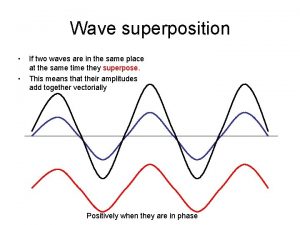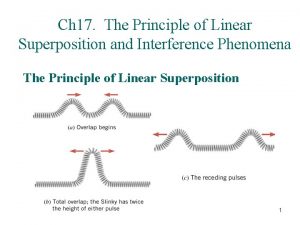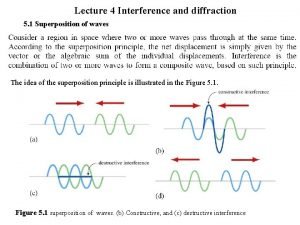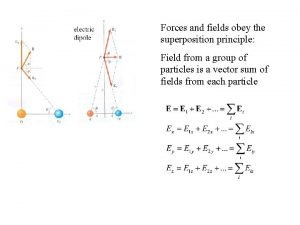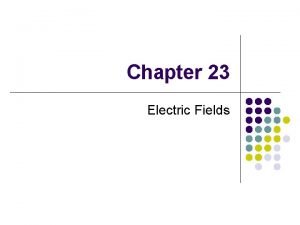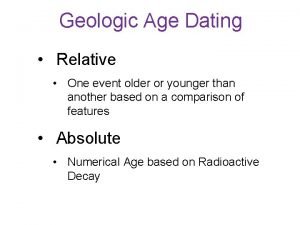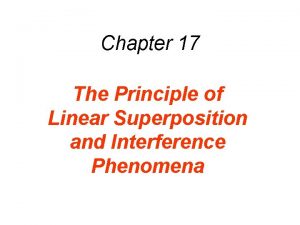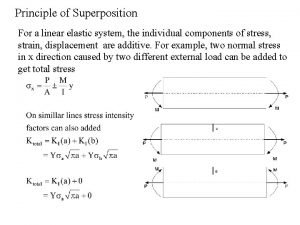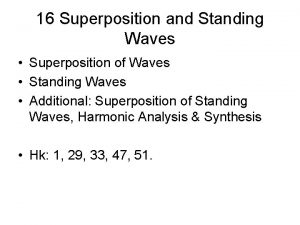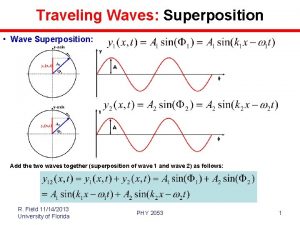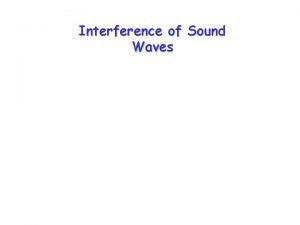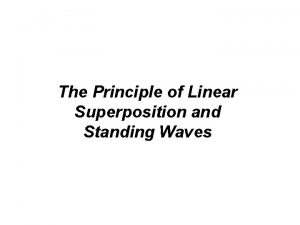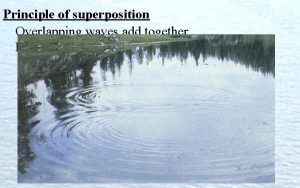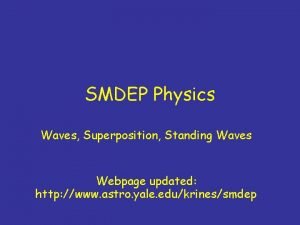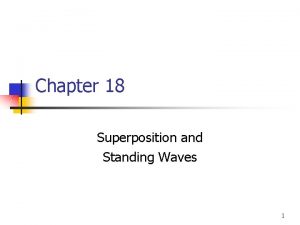Superposition of Waves Principle of Superposition What happens




















- Slides: 20

Superposition of Waves

Principle of Superposition • What happens when two or more waves travel through a medium at the same time? – Each wave affects the medium independently • Principle of Superposition: states the displacement of a medium caused by two or more waves is the algebraic sum of the displacements caused by the individual waves

Interference • The result of the superposition of two or more waves is called interference • Can be constructive or destructive

Constructive Interference • Occurs when the wave displacements are in the same direction • The result is a wave with larger amplitude than any of the individual waves • The amplitude of the larger pulse is the algebraic sum of the amplitudes of the two pulses • After the two pulses have passed through each other the regain their original shape and size • Pulses are not changed by their interaction

Constructive Interference

Destructive Interference • Two pulses with equal but opposite amplitudes • As the two pulses overlap, the displacement of the medium at each point in the overlap is reduced • When the pulses are at the same location, the displacement is zero • The pulses keep moving and resume their original form • An important characteristic of waves is the ability to pass through one another unchanged • If the pulses have unequal amplitudes the destructive interference is not complete. • The pulse at overlap is the algebraic sum of the two pulses

Destructive Interference

Standing Waves • Two pulses with equal but opposite amplitudes meet – You can find one point in the medium that is completely undisturbed at all times – This point is called a node • The medium is never displaced • Produced by the destructive interference of waves – Two pulses with equal amplitudes in the same direction meet • One point undergoes the greatest displacement • Its maximum amplitude is equal to the sum of the amplitudes of the two pulses • Called the ANTINODE

Standing Waves • A standing wave has – Stationary nodes – Stationary antinodes • Result of identical waves traveling in opposite directions • Wave appears to be standing still

Standing Waves

Reflection of Waves • Studied by using a ripple tank • The direction of waves moving in two or three dimensions is often shown by ray diagrams – Ray: line drawn at a right angle to the crest of the wave – Shows only the direction of the waves, not the actual waves – The direction of the barrier is also shown by a line drawn at a right angle to it – Figure 14 -17 p 299

Reflection of Waves • The normal is the line drawn perpendicular to the barrier • The angle between the incident ray and the normal is called the angle of incidence • The angle between the normal and the reflected ray is called the angle of reflection. • The law of reflection states that the angle of incidence is equal to the angle of reflection

Reflection of Waves

Refraction of Waves • Can use a ripple tank to study the behavior of waves as they move from one medium into another • Place a glass plate at the bottom of the ripple tank…the water is now shallower in this spot • The velocity of water waves depends on the water depth so the water above the plate acts like a different medium

Refraction of Waves • How does the velocity of waves depend on water depth? – Wavelength decreases and the direction of the wave changes – Frequency is not changed – From the equation v=λf, the decrease in wavelength means the velocity is lower in the shallower water

Refraction of Waves • Not only does the wavelength decrease over the shallower bottom • The direction of the wave changes as well • The change in direction of waves at the boundary between two different media is known as refraction

Diffraction and Interference of Waves • When waves encounter a small hole in a barrier they do not pass straight through • They bend around the edges of the barrier, forming circular waves that spread out • Figure 14 -19 p 300 • The spreading of waves around the edge of a barrier is called diffraction

Diffraction and Interference of Waves • Diffraction also occurs when waves meet a small obstacle • They can bend around the obstacle producing waves behind it • The smaller the wavelength in comparison to the size of the obstacle, the less the diffraction

Diffraction and Interference of Waves • Fig 14 -20 a p 301 shows the result of waves striking a barrier having two closely spaced holes • The waves are diffracted by each hole, forming circular waves • The circular waves interfere with each other • There are regions of constructive interference where the resulting waves are large • There also bands of destructive interference where the water remains undisturbed

Diffraction and Interference of Waves • The antinodes lie on lines called antinodal lines. • These lines radiate from the barrier, Figure 14 -20 b p 301 • The lines of nodes or nodal lines lie between adjacent antinodal lines
 Superposition of waves
Superposition of waves Principle of linear superposition
Principle of linear superposition Superposition of waves
Superposition of waves Electric field superposition
Electric field superposition What is the smallest lithostratigraphic rock unit?
What is the smallest lithostratigraphic rock unit? Superposition principle for electric field
Superposition principle for electric field Geologic history
Geologic history Linear superposition
Linear superposition Fossil layers
Fossil layers Principle of superposition in stress and strain
Principle of superposition in stress and strain Example of mechanical wave
Example of mechanical wave Compare and contrast p waves and s waves using venn diagram
Compare and contrast p waves and s waves using venn diagram Sound waves longitudinal waves
Sound waves longitudinal waves The wave chapter 13
The wave chapter 13 Mechanical waves and electromagnetic waves similarities
Mechanical waves and electromagnetic waves similarities Electromagnetic waves are longitudinal waves true or false
Electromagnetic waves are longitudinal waves true or false Electromagnetic and mechanical waves
Electromagnetic and mechanical waves What is a semiconductor used for
What is a semiconductor used for Surface waves and body waves
Surface waves and body waves Example of a mechanical wave
Example of a mechanical wave Aimtoknow
Aimtoknow
